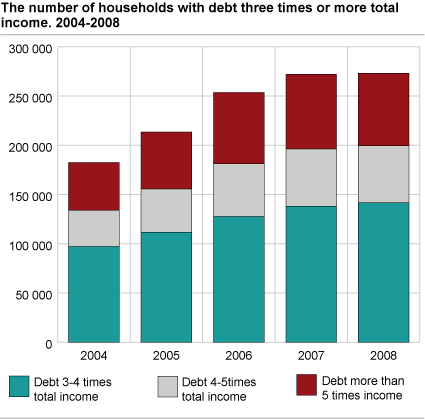Content
Published:
This is an archived release.
Many households have a high debt burden
A total of 273 000 Norwegian households had a debt more than three times the size of their household income in 2008. In 74 000 of these households the debt exceeded the annual income more than five times.
Norwegian households have increased their debt burden over the past years. From 2004 to 2008 the proportion of households with a debt more than three times the size of their income increased from 9.1 to 12.9 per cent. The Financial Supervisory Authority of Norway generally recommends the banking sector not to give loans to private households higher than three times their income before taxes.
The number of households with an even higher debt burden has also increased in recent years. From 2004 to 2008 the number of households with debt more than five times the size of income increased from 49 000 to 74 000 households. However, compared to 2007, the number of households with such a high debt was somewhat lower in 2008.
Underlying data
As of 2004, the household income statistics are based solely on register data, including all persons in private households living in Norway at the end of the year. Persons in student households are not included. In addition to registered cash income received by households, the statistics also include debt and wealth registered in the tax assessment. Thus, the valuation of wealth is based on the tax assessment value. Consequently, the statistics show a lower value on some objects than the actual market value. This primarily applies to real properties (for instance the value of private homes). The property value is also affected by changes in the tax rules. See About the statistics for more information .
Tables:
- Table 1 Property account for households. 2007 og 2008. NOK million, part of households that have amount on the different property codes and average
- Table 2 Number of households, by size of debt compared to total income, 2008-NOK. 2004-2008. Per cent
- Table 3 Households by size of taxable financial capital and type of household. 2008. Per cent
- Table 4 Households by size of debt and type of household. 2008. Per cent
- Table 5 Average debt and per cent changes in average debt for households in different deciles for total household income. 2004-2008. NOK and per cent
- Table 6 Households with bank deposits higher than 1 G (Basic amount of the National Insurence )
The statistics is published with Income and wealth statistics for households.
Additional information
The statistics are based on register data, including all persons in private households. Persons in student households are not included. Registered cash income and debt and wealth registered in the tax assessment are included.
Contact
-
Statistics Norway's Information Centre
E-mail: informasjon@ssb.no
tel.: (+47) 21 09 46 42

